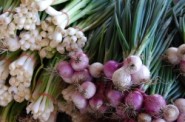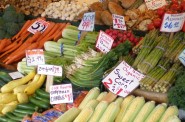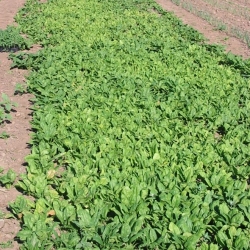Why Hmong-Grown Produce is Different?
Custardy cucumbers. Fat and happy collard greens. Hmong farmers grow things in different ways.
Hmong farmers. You see them at just about every farmers market in the Wisconsin. They smile and sell piles and piles of low-priced, gorgeous produce, yet the language barrier keeps many people from getting to know them better. They have been part of this city’s community — and farmers markets — for decades now. Yet myths about Hmong farmers abound — some benign, some downright harmful.
When I arrived in Milwaukee in 2003 to run the Fondy Food Center, they were a mystery to me as well. My family is from Korea – a country with a rugged landscape and climate that more closely resembles Idaho than the humid forests and hills of Southeast Asia that the Hmong call home. I tell people that in European terms, the Koreans are Irish and the Hmong are Sicilian. Irish and Sicilians are similar in that both groups bake bread, and that’s about it. I’d heard stories about the Hmong when they began arriving in the US in the late 1970s, about how they’d been recruited by the CIA to fight its Secret War in Laos, an outgrowth of the Vietnam War. More than 100,000 Hmong died by the time the US pulled out of Vietnam.
Until 2003 my only real exposure to farms was what I saw on TV or in the car on summer vacations: shiny tractors, red barns tall grain silos and acres and acres of identical-looking plants standing in laser-straight rows.
When my staff began visiting and inspecting the growing operations of the Hmong farmers that supplied our market, I tagged along. And it’s taken me nine years of working with Hmong farmers to understand the seemingly weird things I saw that day.
The rows were anything but straight. Certain leafy vegetables like salad, collard, and mustard greens weren’t even planted in rows. Instead the seeds were “broadcast” by hand — like you would plant grass seed on your front lawn – into six-foot-wide patches. I didn’t see any tractors. The largest piece of equipment I saw was a sad looking rototiller, stored under an old plastic shower curtain to keep it from rusting further.
Where these Hmong farmers put their plants also made no sense to me. Six tomato plants were next to some zucchini vines, followed by some watermelons, then cabbages, peppers, cantaloupes, then maybe another six tomato plants. I remember thinking, “Wouldn’t it be more efficient if they put all their tomato plants in one spot?”
I saw a gigantic cucumber, 18 inches long and about five inches thick, that had been on the vine for so long it had started to go to seed and turn yellow. In my eyes the farmer had waited too long to pick it. In my mind I decided that this farmer was lazy.
But as I’ve watched these Hmong farmers plant, harvest, and haul in the half million pounds of fruits and vegetables that get sold at Fondy each year, I came to realize these folks are anything but lazy. I’ve now come around to thinking the Hmong have some things to teach Wisconsin farmers.
Traditional American farmers use techniques handed down from their European ancestors, where planting in rows made sense if you had a team of horses or, later, a tractor. But if you don’t have a tractor, who needs rows?
Hmong farmers have discovered that leafy plants such as collard greens don’t like to be confined into orderly rows. They do better when they’re broadcast seeded into a random pattern that mimics nature. There’s less competition for sunlight that way, and instead of growing long, narrow leaves that try to reach for the sun, the leaves become happy, fat, and wide – a sought-after quality in the African American community that our market serves.
And that huge cucumber I saw? I’ve learned that, while Americans and Europeans pick their cucumbers when they’re young and immature, Hmong and other Asian cultures like cucumbers that are close to going to seed. A ripened cucumber is a completely different vegetable. The crisp, still-green texture is replaced by a velvety, custard-like mouth feel.
Despite all of their agricultural talents, Hmong farmers in Wisconsin still face many challenges. They tend to lack access to financial institutions, can’t afford to buy farmland, and rent their land with handshake leases, sometimes at rates three times higher than their mainstream counterparts. They also have to contend with many myths and outright stereotypes from suspicious Wisconsinites who simply don’t know better.
For example, once a month I get a call from a Fondy Farmers Market customer who has heard the Hmong use fresh human waste for fertilizer. I don’t know how this idea came about. But I do know that most of my Hmong farmers live in Milwaukee and I have a hard time imagining any of them storing and then transporting sloshing buckets of feces all the way out to their fields in Germantown or Mequon. Over a hundred farm inspections have failed to turn up a single bucket of poop.
The Hmong are also known for igniting price wars at farmers markets, a reputation that does have some merit. Farmers market operators like myself aren’t allowed to use their influence to pressure farmers to raise or lower their prices thanks to the Sherman Antitrust Act. Our hands are tied. I used to think the Hmong kept their prices low because they didn’t use “modern” accounting methods to track their production costs. But after trying to teach basic accounting skills to Hmong farmers for the past two years, I’m not so sure. I think what we’re seeing in the Hmong is a different kind of farming – one that isn’t driven solely by dollars and cents and profit. Sure, money does play a role, but it’s mixed in with other drivers that make a person work for 80 hours a week in the hot Wisconsin summer sun – things like personal happiness, socializing with fellow farmers at a farmers market, feeding people, or keeping the Hmong farming tradition alive. These are things that defy monetization.
At the Fondy Market this summer I encountered an older Hmong farmer selling the most beautiful Jersualem artichokes, a North American root vegetable that’s not cultivated in Asia. Our language barrier prevented me from asking him how he discovered this plant. He was selling them for a song. I decided to skirt the Sherman Antitrust Act and pointed to the $2 price tag. “Too cheap,” I said. He nodded, smiled, then shook his head. No, that price tag wasn’t going down. He would continue to happily offer this freshly harvested bargain to his customers.
Recent Urban Foodie Articles
Urban Foodie
-
The Junk Food Debate
 May 14th, 2013 by Young Kim
May 14th, 2013 by Young Kim
-
Tips for Twenty-Somethings
 Mar 15th, 2013 by Young Kim
Mar 15th, 2013 by Young Kim
-
Eating With The Season
 Oct 21st, 2012 by Young Kim
Oct 21st, 2012 by Young Kim


















Wonderful article! Really helpful to those of us trying to grow food systemically in home gardens. This is similar to the concept of permaculture (google it) that creates an ecosystem of food production on a small plot of land.
Very well written. Thank you Mr. Kim.
Sam Lou
Hi Young Kim, thanks for an excellent article that not only educates us on Hmong farming techniques, which I found fasinating, but provided us a sensitive look at the Hmong culture’s compassion for the land, family traditions, and the community. Yes, the language barrier does keep us from interacting more with the Hmong community. But judging from the success that you have had with both the Hmong farmers and the African American community that you serve, understanding is being forged through the exchange of healthy produce at the Fondy’s Farmers Market.
Great article — very interesting and enlightening!
Thank you Mr. Kim for writing this story and for the work you do with the Hmong farmers and the community at large. I had the pleasure of seeing and hearing about the Hmong farms in Port Washington. Stephen Petro, the farm manager was an excellent, most gracious and well-informed guide. As I understand it, the farm was an inspiration that came to you after asking ‘why’ when you faced explainable changes in farmer participation at the Fondy market, several years ago.
What I appreciated most about this article is the description of your thought processes – continuing to ask ‘why’. When we have the ability to suspend our judgment, investigate our mental models and inquire as to what information might we not have or not understand, then we are open and ready for new insights that can lead us to new discoveries.
I loved this. Thank-you.
Thank you for the informative write. This helps me understand my own culture even more (Hmong). This also explains why our little home garden (approx. 40x60ft) is able to provide enough greens throughout the season. We have a big family and there’s always an abundance. It is in fact the same method used for home gardening. When one produce has gone through its own cycle, we just plant a different produce.
Just to add; those big yellow/green cucumbers, you are correct in that it is an entirely different experience and taste. We also save those for its seeds for replanting.
Again, very good article. Thanks for shedding some light about the Hmong community.
To my fellow Hmong Milwaukeeans – thank you for making my food. You are helping raise my child by providing him healthy, nutritious, local vegetables and a happy tradition of shopping at Fondy Market. We especially love supporting the farmers who grow at Fondy Farm in Port Washington. It is fitting that this weekend marks the traditional Hmong New Year, a celebration to mark the end of the harvest and to give thanks. Happy New Year!!!
Thank you Kim for a great article. I’ve been working with Hmong farmers for many years and impressed by the amount of products they are able to produce with the amount of land they have.
Thank you for a wonderful article.
This reminds me of when I lived in Guatemala for a year. When I first arrived I remember looking at Guatemalan corn fields, and thinking, “look at those messy corn fields”. The corn plant heights were all different, they were planted far apart, and there were beans growing all over the place, and maybe an avocado tree or cherimoya tree plonked in the middle of the field. Household “gardens” were similarly messy. They didn’t really look like gardens. Around the compound there were pots of tomato plants here and there among beautiful flowers. Huge chayote squash vines planted at the base of a tree threatened to engulf the trees, and often escaped the compound walls into the neighbors’ yard, feeding them. Fruit trees in the yard often had clothes lines attached to them.
Then, after living in Guatemala for a year, I came back to Wisconsin. I saw acres and acres of corn, planted in straight rows, very close together. It didn’t look “neat and orderly” anymore. It looked creepy and disturbing.
Years later, I read Michael Pollan’s book “The Omnivore’s Dilemma”. Suddenly I understood what I had been seeing in Guatemala; the natural diversity in a farm field that occurs when farmers save and plant their own seeds and an intense cultivation that benefits some plants when the are planted close together.
Then when I started planting my own garden the “logic” of orderly rows for my salad mix suddenly seemed completely illogical–why plant everything in a row, when you are wasting valuable dirt in between and harvesting everything by hand anyway? Indeed, the Hmong have a lot to teach us, and we have a lot to re-learn.
Mr. Kim
Although you appear to attempt to provide a positive view, your article is rather condescending. You don’t know what you’re talking about. You don’t even know that the Sherman Anti-trust laws don’t event apply to individuals, but rather it only applies to monopolies of persons and groups who secretly agree to distort prices to destroy the competition. You don’t know that Hmongs aren’t so simple as you try to make them appear.
Great article Young! This reminded me of the efficiency of the “Three Sisters” (corn, beans & squash) garden of the Iroquois and other indigenous farming cultures:
“The corn stalk offers itself as a structure for the beans to climb on. While the beans supply the corn with needed nitrogen as well as well as improving the overall fertility of the soil. When the beans climb the corn stalk, it also provides the stalk with added stability from strong winds. The squash vines grow at the base of the bean and corn plants and provide a type of living mulch to help conserve water and provide weed control. The roots from the squash vines are shallow and will not invade the roots of the other plants. Once the plants have been harvested they can be incorporated into the soil as organic compost, thus fertilizing the soil even more. In this approach, the efficiency of space is not only beneficial, but it is also very easy to achieve results.” from http://www.readynutrition.com
Thank you for writing such a wonderful article! I loved how you described your thought process logically, researched and made your mindful conclusions. Thank you for not stopping at your initial biases as many do and chose to learn and find the beauty in the simple different ways ‘Sicilians’ garden and do business=).
Ps, major props for defending exasperating claims against the Hmong farmers. I laughed out loud at the example of farmers hoarding excrements!
-Former Wisconsinite
Actually, the Hmong have a long, long history of adapting their agriculture to different biomes. Their ancestors originally lived somewhere in central China, where the climate is not that different from the interior of the U.S. Like many minority populations, they were pushed out to the periphery of China by the expanding majority Han population, and over the course of hundreds of years had to redevelop their agriculture and cuisine to contend with increasingly tropical conditions. They did not settle the highlands of mainland Southeast Asia until the 1720s, arriving there about the same time that English and German farmers in colonial America began to push inland from the Atlantic coast. Horses do not generally do well in hilly country, or in the tropics, and plowing with animals (water buffalo) or tractors just isn’t cost effective if your fields are very small. Gardening, however, is cost effective if you have sufficient human labor. So, the Hmong farming methods we see in Wisconsin – and their ability to adapt to North American crops – probably reflects a poorly-studied tradition of quiet, appropriate, effective innovation. American farmers, by contrast, have altered the natural environment with technology to provide artificial conditions for alien crops. Coming to the U.S. with very little capital, the Hmong employed what they had – family labor – and built a farming system that was appropriate for intensive hand labor.
Passerby:
I’ve consulted with several attorneys on the issue of pricing at the Fondy Farmers Market. Section One of the Sherman Anti-Trust Act makes price fixing illegal. I’m not allowed to convene farmers and make backroom deals where we all agree to charge XX for potatoes. We’re supposed to let the free market determine prices.
As for the assertion that this is a simplistic portrayal of the Hmong … this is just a snapshot of my current understanding of Hmong farmers. It sounds like you feel I’ve left some things out. I’d love to hear what you think those things are.
– Young Kim
The Sherman Anti-Trust act, the key word in Section I is conspiracy. Whereas there is no conspiracy, there can be no violation. Just because other farmers overvalue their produce, doesn’t imply that the Hmong undervalue theirs. There is no conspiracy among the Hmong farmers to undervalue their produce to purposely destroy the livelihood of the other farmers. The sherman anti-trust act is meant to protect consumers from people who would try to destroy others so they can create a monopoly. Being that the Hmong are doing neither then there is no case. It’s just a simple matter of supply and demand. They would rather sell all their produce than have them rotting in the gardens. Whereas many other farmers would rather dump their produce into the ocean and receive gov’t subsidies to only produce a certain amount of produce.
I’m not implying that other farmers get subsidies, because I realize it’s just the large corporations that do, and not the local farmers, but that was just an example.
BTW, i like your calmness in your response. Keep it real Mr. Kim. You seem like a great guy.
Young – very insightful article. About 1/3 of our growers here in Webb City, MO, are Hmong and while we’ve done a lot of training to help them improve productivity in our climate (“In Minnesota, it rains during the summer….), soil and in the midst of our pests, some of their techniques have proven useful for our native-born farmers – like planting boc choy and other greens in “pools” rather than rows. Some of our customers who served in Korea and Vietnam have the “poo” concern – apparently they saw it there, but all our farmers are food safety trained and when I asked one of my farmers about using human – or pig – waste in his fields, he was horrified. He knew better.
The Hmong are among the hardest working folks I’ve ever been around – especially my lady farmers – at the farm when they’re showing me around, no weed remains unplucked and if their husbands are showing me around they are wielding a hoe constantly.
subsistence farming is still the best to practice.